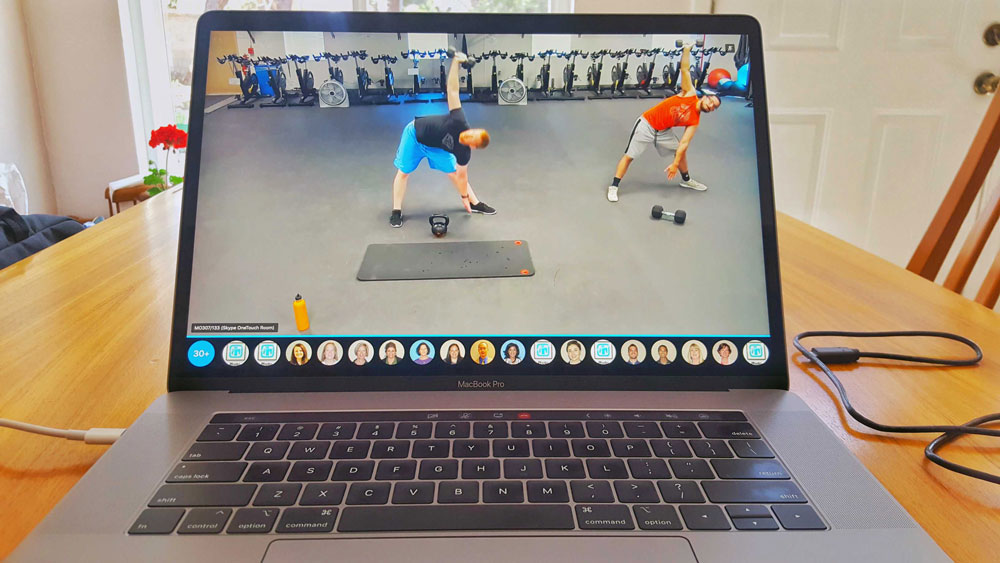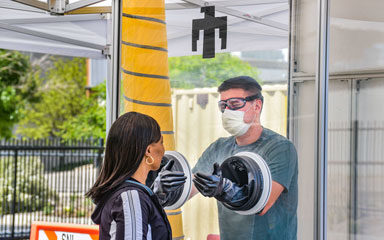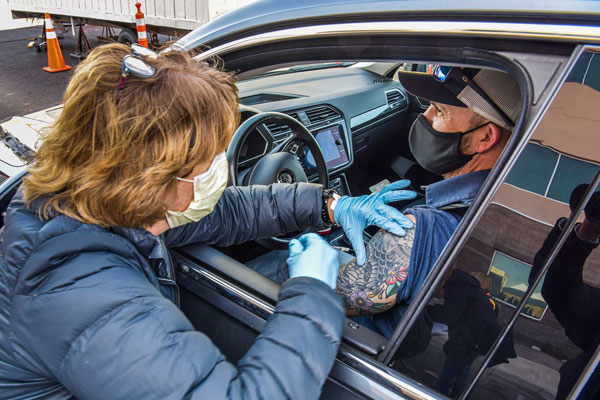A look back at how Employee Health Services’ rapid response has helped keep the workforce safe

It has been two years since the World Health Organization declared COVID-19 a pandemic on March 11, 2020. While the pandemic has changed all our lives, it has been especially hard for health care workers nationwide who have had to change the way they provide services, learn how to treat a novel disease and continuously transition through the ebbs and flows of COVID-19 and its variants. As we enter the third year of this reality, we reflect on the Labs’ initial response and recognize the resiliency of Sandia’s own medical staff.
Around the same time that the United States recorded its first case of COVID-19 in January 2020, Sandia’s leadership team was proactively gathering representatives from across the Labs to begin planning for the inevitable.
Sandia’s Pandemic Response Team quickly engaged cross-organizational leaders who monitored the global progression of COVID-19 to ensure Sandia had an effective system in place to remain operational. One important tool in the team’s arsenal was a Pandemic Disease Response Plan that had been revised between August and December of 2019. A requirement for DOE within Sandia’s Continuity of Operations Plan, this high-level framework provided guidance on how to activate a response to a biological threat — whether a natural disease outbreak or a terrorist attack — to protect the health and wellness of the workforce and ensure mission essential functions could continue.
The plan had been exercised annually during Sandia’s flu shot clinics and proved to be helpful in kicking off the COVID-19 pandemic response and engaging the Labs’ leadership team before the virus reached Sandia sites. However, it didn’t include details on how to manage the pandemic or how to shut down the response afterward, former director of Employee Health Services Renee Holland explained.
“It was great to have so that we could have the communication ready to go and a plan to kick off when we needed to activate for the COVID-19 pandemic, but we’re still working through how we need to evolve it and how the Continuity of Operations needs to expand at Sandia because it’s a high-level framework,” she said in July 2021. “I don’t think anything could have had us as prepared as we needed to be to evolve for COVID-19 because it was such a high-level, detailed response that was needed.”
Shifting services
A major part of that detailed response was the change in services that Sandia’s Medical Clinic provided to the workforce. While some services had to be put on pause, many shifted throughout the pandemic and even more were added.

“We basically changed 100% of our operations in less than 90 days as we were starting to treat people,” Renee said. “We had to change every workflow we had to respond to COVID-19.”
In-person services like group fitness classes and corporate fitness facilities were paused, and people needing personal health care services and nonemergency care were encouraged to work through their community primary care provider. The clinic still continued a majority of services though, like providing emergency medical services, treating work-related injuries and illnesses, conducting return-to-work and restriction reviews, streaming preventive health services, offering flu shots and allergy shots by appointment and counseling employees telephonically through the Employee Assistance Program.
On top of continuing many day-to-day operations, Employee Health Services expanded its capabilities to respond specifically to COVID-19 and keep essential workers safe, especially those who remained on-site. Within a few months, they prepared to primarily treat upper respiratory infections, created quarantine guidance, set up testing, managed those who self-identified as high risk for complications, developed a Health Check app and monitored risk indicators, conducted contact tracing and moved from an in-person service model to a telephonic service model.
In 2020, the team adopted online platforms for telephonic and video visits. This year, Employee Health Services is evaluating a hybrid model of care.
“We are beginning to pivot again to provide more on-site services while still offering services virtually. We want to connect with staff where they prefer,” said Kim Pohl, senior manager of Employee Health Services.
On the front lines

The medical providers in particular had to adapt to COVID-19 quickly, learning how to treat conditions outside their specialties and become experts on new guidance that changed often.
“A lot of these providers spent a lot of years in school, and they didn’t pick the specialty to respond to a pandemic or pick upper respiratory COVID-19 type work. It wasn’t something that was their life’s passion and goal, but they all met the challenge, became the experts and pivoted from their normal passions to support the pandemic efforts. That’s a hard challenge to face, especially in an environment where health care professionals in the community were highly sought after,” Renee said.
Adding and pivoting medical services during a time when health care professionals in the community were in high demand presented challenges of its own. It was a hard market to find enough of the right kind of workers to meet the response. Before the pandemic, the Employee Health Services center included about 90 doctors, nurses and support staff that all contributed to the Labs’ COVID-19 response. As infections increased, that number varied upwards toward 105 workers to collect COVID-19 tests, manage the front desk and provide medical services. And as vaccines became available, on-site drive-through clinics required even more staff.
“There have been many challenges, primarily stretching existing staff resources to cover the pandemic efforts for a much longer period of time than we initially thought,” Kim said. “Our people are tired, and it has been a challenge to add more staff as health care everywhere is struggling to recruit and retain resources.”
Even with the added challenges, the entire staff has found a way to persevere, adapt and ultimately keep Sandia’s workforce safe amid one of the most unprecedented times in history. Because of them, more than 15,000 employees and contractors across Sandia’s sites have had direct access to medical advice and care, timely COVID-19 test results and vaccines. Sandia’s COVID-19 cases have remained below the local and national levels throughout the pandemic and possible on-site transmission has accounted for just 4% of all cases.
“Since the beginning, staff and Employee Health Services have worked together to meaningfully support the mission at Sandia,” Kim said. “We know we will look back, down the road, and have great memories of the teamwork, the significant effort expended and the impact the team had made for all Sandians.”